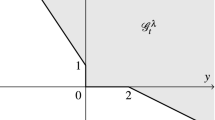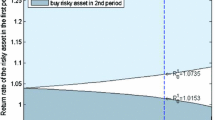Abstract
The aim of this paper is to prove the fundamental theorem of asset pricing (FTAP) in finite discrete time with proportional transaction costs by utility maximization. The idea goes back to L.C.G. Rogers’ proof of the classical FTAP for a model without transaction costs. We consider one risky asset and show that under the robust no-arbitrage condition, the investor can maximize his expected utility. Using the optimal portfolio, a consistent price system is derived.
Similar content being viewed by others
Notes
Given \(X_{T} \in\mathcal{A}^{0}_{T}\) such that E[U(X T )−]=∞, we set E[U(X T )]:=−∞.
References
Barron, E.N., Cardaliaguet, P., Jensen, R.: Conditional essential suprema with applications. Appl. Math. Optim. 48, 229–253 (2003)
Castaing, C., Valadier, M.: Convex Analysis and Measurable Multifunctions. Lecture Notes in Math., vol. 580. Springer, Berlin (1977)
Campi, L., Owen, M.P.: Multivariate utility maximization with proportional transaction costs. Finance Stoch. 15, 461–499 (2011)
Cvitanić, J., Karatzas, I.: Hedging and portfolio optimization under transaction costs: a martingale approach. Math. Finance 6, 113–165 (1996)
Czichowsky, C., Muhle-Karbe, J., Schachermayer, W.: Transaction costs, shadow prices, and duality in discrete time. SIAM J. Financ. Math. 5, 258–277 (2014)
Dalang, R.C., Morton, A., Willinger, W.: Equivalent martingale measures and no-arbitrage in stochastic securities market models. Stoch. Stoch. Rep. 29, 185–201 (1990)
Delbaen, F., Schachermayer, W.: The Mathematics of Arbitrage. Springer Finance. Springer, Berlin (2006)
Deelstra, G., Pham, H., Touzi, N.: Dual formulation of the utility maximization problem under transaction costs. Ann. Appl. Probab. 11, 1353–1383 (2001)
Harrison, J.M., Kreps, D.M.: Martingales and arbitrage in multi-period securities markets. J. Econ. Theory 20, 381–408 (1979)
Harrison, J.M., Pliska, S.R.: Martingales and stochastic integrals in the theory of continuous trading. Stoch. Process. Appl. 11, 215–260 (1981)
Kabanov, Y., Rásonyi, M., Stricker, Ch.: No-arbitrage criteria for financial markets with efficient friction. Finance Stoch. 6, 371–382 (2002)
Kabanov, Y., Rásonyi, M., Stricker, Ch.: On the closedness of sums of convex cones in L 0 and the robust no-arbitrage property. Finance Stoch. 7, 403–411 (2003)
Kabanov, Y., Safarian, M.: Markets with Transaction Costs—Mathematical Theory. Springer Finance. Springer, Berlin (2010)
Pennanen, T.: Dual representation of superhedging costs in illiquid markets. Math. Financ. Econ. 5, 233–248 (2011)
Rásonyi, M., Stettner, L.: On utility maximization in discrete-time financial market models. Ann. Appl. Probab. 15, 1367–1395 (2005)
Rásonyi, M.: New methods in the arbitrage theory of financial markets with transaction costs. In: Donati-Martin, C., Émery, M., Rouault, A., Stricker, Ch. (eds.) Séminaire de Probabilités XLI. Lecture Notes in Mathematics, vol. 1934, pp. 455–462. Springer, Berlin (2008)
Rásonyi, M.: Arbitrage with transaction costs revisited. In: Delbaen, F., Rásonyi, M., Stricker, Ch. (eds.) Optimality and Risk—Modern Trends in Mathematical Finance, pp. 211–226. Springer, Berlin (2009)
Rogers, L.C.G.: Equivalent martingale measures and no-arbitrage. Stoch. Stoch. Rep. 51, 41–49 (1994)
Rokhlin, D.B.: A theorem on martingale selection for relatively open convex set-valued random sequences. Math. Notes 81, 543–548 (2007)
Rokhlin, D.B.: Constructive no-arbitrage criterion under transaction costs in the case of finite discrete time. Theory Probab. Appl. 52, 93–107 (2008)
Schachermayer, W.: A Hilbert space proof of the fundamental theorem of asset pricing in finite discrete time. Insur. Math. Econ. 11, 249–257 (1992)
Schachermayer, W.: The fundamental theorem of asset pricing under proportional transaction costs in finite discrete time. Math. Finance 14, 19–48 (2004)
Acknowledgements
The authors thank the Deutsche Forschungsgemeinschaft (DFG) for financial support.
Author information
Authors and Affiliations
Corresponding author
Appendix
Appendix
We want to prepare the proof of Lemma 3.3. Given two sub-σ-fields \(\mathcal{A}_{0} \subset\mathcal{A}_{1}\) and \(0 < \underline{X}_{0} \le\overline{X}_{0}\) \(\mathcal{A}_{0}\)-measurable as well as \(0 < \underline{X}_{1} \le\overline{X}_{1}\) \(\mathcal{A}_{1}\)-measurable, we assume that
is a vector space. It is straightforward to check that under this assumption
and \(A:=\{ \mathbf {E}[ |\underline{X}_{1} - \overline{X}_{0} | \,\vert\, \mathcal {A}_{0} ] = 0 \}\) is the biggest \(\mathcal{A}_{0}\)-measurable set such that
For ω∈A, we define P
0(ω) to be the orthogonal projection on the linear space generated by  ; for ω∉A, we set P
0(ω):=0. Then we have P
0
v=v iff \(v \in\mathbf{L}^{0}(-K(\underline{X}_{0}, \overline{X}_{0}), \mathcal{A}_{0}) \cap\mathbf{L}^{0}(K(\underline{X}_{1}, \overline{X}_{1}), \mathcal{A}_{1})\).
; for ω∉A, we set P
0(ω):=0. Then we have P
0
v=v iff \(v \in\mathbf{L}^{0}(-K(\underline{X}_{0}, \overline{X}_{0}), \mathcal{A}_{0}) \cap\mathbf{L}^{0}(K(\underline{X}_{1}, \overline{X}_{1}), \mathcal{A}_{1})\).
The following lemma is a version of Proposition 3.3 from [15]. We write \(\ell^{X_{1}}(v)\) for the liquidation value of v with respect to the bid and ask prices \(\underline{X}_{1}, \overline {X}_{1}\), i.e.
The liquidation value is continuous in v and satisfies ℓ(αv)=αℓ(v) for α≥0. This is why the proof from [15] also works (with the obvious changes) in our model with transaction costs.
Lemma A.1
If \(\mathbf{L}^{0}(-K(\underline{X}_{0}, \overline{X}_{0}), \mathcal{A}_{0}) \cap\mathbf{L}^{0}(K(\underline{X}_{1}, \overline{X}_{1}), \mathcal{A}_{1})\) is a vector space, then there exists a strictly positive \(\mathcal {A}_{0}\)-measurable γ 0 such that
for every \(v \in\mathbf{L}^{0}( -K (\underline{X}_{0}, \overline{X}_{0}), \mathcal{A}_{0})\) which satisfies P 0 v=0 and |v|=1.
Proof of Lemma 3.3
For t=0,1, we pick an \(\mathcal{A}_{t}\)-measurable \(S_{t} \in \operatorname {ri}[\underline{X}_{t}, \overline{X}_{t}]\) and set for α t ∈(0,1)
We fix α 1∈(0,1) such that \(2 (1-\alpha_{1}) (1+\overline {X}_{1}^{2}) < \gamma_{0}/2\). It follows from

and

for every |v|=1 that
for every \(v \in\mathbf{L}^{0} (-K(\underline{X}_{0}, \overline{X}_{0}), \mathcal{A}_{0})\) which satisfies P 0 v=0 and |v|=1.
We have \(v - P_{0}v \in\mathbf{L}^{0} (-K(\underline{V}_{0}, \overline {V}_{0}), \mathcal{A}_{0})\) and \(\ell^{V_{1}}(v)=\ell^{V_{1}}(v-P_{0}v)\) for every \(v \in\mathbf{L}^{0} (-K(\underline{V}_{0}, \overline{V}_{0}), \mathcal {A}_{0})\). Thus, it is enough to find an appropriate α 0 such that
for every \(v \in\mathbf{L}^{0} (-K(\underline{V}_{0}, \overline{V}_{0}), \mathcal{A}_{0})\) with P 0 v=0. We can assume that |v|=1 on {v≠0}. It is straightforward to check that then

where \(c(\alpha_{0}):=(1/\alpha_{0} - 1) (1 + S_{0}^{2})\). Note that (id−P 0)(v−c(α 0)e 0)≠0 a.s. and c(α 0)↓0 as α 0↑1. Now
implies on {v≠0} that
We fix α 0 near 1 such that the last expression is strictly negative. It follows that
for every \(v \in\mathbf{L}^{0} (-K(\underline{V}_{0}, \overline{V}_{0}), \mathcal{A}_{0})\) with P 0 v=0. □
Proof of Lemma 3.5
Claim (a). We show that on \(A=\{ \operatorname {inf}_{\mathcal{H}} \underline{X} =\mathbf {E}_{\mathbf{Q}} [ Z \,\vert\, \mathcal{H} ] \}\), we have \(\inf_{\mathcal{H}} \underline{X} = \sup_{\mathcal{H}} \overline{X}\). Indeed, from \(\operatorname {inf}_{\mathcal{H}} \underline{X} \le\underline{X} \le Z\), we get that \(\operatorname {inf}_{\mathcal{H}} \underline{X} = \underline{X} = Z\) and thus \(\underline{X}=\overline{X}\) on A, since \(Z \in \operatorname {ri}[ \underline{X}, \overline{X} ]\). Then \(\operatorname {inf}_{\mathcal{H}} \underline{X}= \overline{X}\) and \(\operatorname {inf}_{\mathcal{H}} \underline{X} = \operatorname {sup}_{\mathcal{H}} \overline{X}\) on A. Similarly, we get that \(\inf_{\mathcal{H}} \underline{X}\) and \(\sup_{\mathcal{H}} \overline{X}\) coincide on \(\{ \mathbf {E}_{\mathbf{Q}}[ Z \,\vert\, \mathcal{H} ] = \operatorname {sup}_{\mathcal {H}} \overline{X} \} \).
Claim (b). For \(n \in\mathbb{N}\), put
where
Then \(\tilde{a}_{n}, \tilde{b}_{n} > 0\) and \(\mathbf {E}[\tilde{a}_{n} \underline{X} \,\vert\, \mathcal{H}] \rightarrow \operatorname {inf}_{\mathcal{H}} \underline{X}\), \(\mathbf {E}[\tilde{b}_{n} \overline{X} \,\vert\, \mathcal{H}] \rightarrow \operatorname {sup}_{\mathcal{H}} \overline{X} \ \)a.s. as n→∞. Since \(1 \le \mathbf {E}[\tilde{a}_{n} \,\vert\, \mathcal{H}] \le1 + \frac{1}{n}\) and \(1 \le \mathbf {E}[\tilde{b}_{n} \,\vert\, \mathcal{H}] \le1 + \frac{1}{n}\), we normalize \(\tilde{a}_{n}\) and \(\tilde{b}_{n}\), i.e. replace \(\tilde{a}_{n}\) by \(\frac{\tilde{a}_{n}}{\mathbf {E}[ \tilde{a}_{n} \,\vert\, \mathcal{H} ]}\) and \(\tilde{b}_{n}\) by \(\frac{\tilde{b}_{n}}{\mathbf {E}[ \tilde{b}_{n} \,\vert\, \mathcal {H} ]}\), and still have \(\mathbf {E}[\tilde{a}_{n} \underline{X} \,\vert\, \mathcal {H}] \to \operatorname {inf}_{\mathcal{H}} \underline{X}\), \(\mathbf {E}[\tilde{b}_{n} \overline {X} \,\vert\, \mathcal{H}] \rightarrow \operatorname {sup}_{\mathcal{H}} \overline{X} \ \)a.s. as n→∞.
Now we set \(\varOmega_{1} := \{ \operatorname {inf}_{\mathcal{H}} \underline{X} < \operatorname {sup}_{\mathcal{H}} \overline{X} \}\) and \(\varOmega_{2} := \{ \operatorname {inf}_{\mathcal{H}} \underline{X} = \operatorname {sup}_{\mathcal{H}} \overline{X} \}\); thus Ω=Ω 1∪Ω 2. For ω∈Ω 1 (up to a null set), we choose \(n=n( \omega) \in\mathbb{N}\) minimal such that \((\operatorname {inf}_{\mathcal{H}} \underline{X}) ( \omega) \le \mathbf {E}[\tilde{a}_{n} \underline{X} \,\vert\, \mathcal{H}](\omega) < c (\omega)\). Then ω↦n(ω) is \(\mathcal{H}\)-measurable on Ω 1, and \(\tilde{a}\) defined as \(\tilde{a} ( \omega) := \tilde{a}_{n (\omega)} (\omega)\) on Ω 1 and \(\tilde{a} ( \omega) = 1\) on Ω 2 is strictly positive and satisfies \(\mathbf {E}[\tilde{a} \,\vert \, \mathcal{H}] = 1\), \(\mathbf {E}[\tilde{a} \underline{X} \,\vert\, \mathcal {H}] < c \ \mbox{on}\ \varOmega_{1}\). Similarly, \(\tilde{b}\) defined by \(\tilde{b}(\omega) := \tilde{b}_{m ( \omega)} ( \omega)\) on Ω 1, where \(m( \omega) \in\mathbb{N}\) is minimal such that \(\mathbf {E}[ \tilde{b}_{m} \overline{X} \,\vert\, \mathcal{H} ] ( \omega)> c( \omega)\), and \(\tilde{b} ( \omega) = 1\) on Ω 2 is strictly positive and satisfies \(\mathbf {E}[\tilde{b} \,\vert\, \mathcal{H} ] = 1\), \(\mathbf {E}[ \tilde{b} \overline{X} \,\vert\, \mathcal{H}] > c \ \mbox{on}\ \varOmega_{1}\). We put
Then we have \(\mathbf {E}_{\mathbf{Q}} [Z \,\vert\, \mathcal{H} ] = c\), where \(Z:=\frac{a\underline{X}+b\overline{X}}{a+b} \in \operatorname {ri}[\underline{X},\overline{X}]\) and Q is defined by \(\frac {\mathrm{d} \mathbf{Q}}{\mathrm{d}\mathbf {P}} := a+b\). □
Proof of Lemma 3.6
Closedness of F follows from the fact that φ(0)≤φ(ta) for a∈F, t>0, due to concavity. Fix a closed \(K \subset \{x \in\mathbb{R}^{d} \, : \, |x|=1\}\) and choose a sequence \((x_{j})_{j=1}^{\infty}\) of \(\mathcal{H}\)-measurable random variables with values in K such that \((x_{j}(\omega))_{j=1}^{\infty}\) is dense in K∩C(ω) on the event {K∩C≠∅}. Then
Closedness of A is clear. Now, for a fixed \(K \subset\mathbb{R}^{d}\) which is supposed to be compact, we choose a sequence of \(\mathcal {H}\)-measurable random variables \((y_{j})_{j=1}^{\infty}\) with values in K such that \((y_{j}(\omega))_{j=1}^{\infty}\) is dense in K∩C(ω) on the event {K∩C≠∅}. Further, let \((c_{n})_{n=1}^{\infty}\) be a sequence of \(\mathcal{H}\)-measurable random variables such that \((c_{n}(\omega))_{n=1}^{\infty}\) is dense in C(ω). Then
Now, by straightforward measurable selection arguments (see Theorem III.6 in [2] and use the fact that in \(\mathbb{R}^{d}\), every open set is a union of compact sets), α and β can be defined in an \(\mathcal{H}\)-measurable way. □
Remark A.2
We can find an equivalent measure P′ such that \(\mathbf {E}_{\mathbf{P}^{\prime}} [U(\ell(v)) \,\vert\, \mathcal{F}_{t-1}]\) and \(\mathbf{E}_{\mathbf{P}^{\prime}} [U^{\prime}(\ell(v)) \,\vert\, \mathcal {F}_{t-1}]\) are finite for every \(v \in\mathbf{L}^{0} (\mathbf{R}^{2}, \mathcal{F}_{t-1})\). Further, we can find a version of \(\mathbf {E}_{\mathbf{P}^{\prime}} [U(\ell(a)) \,\vert\, \mathcal{F}_{t-1}]\) for every \(a \in\mathbb{R}^{2}\) such that for every scenario ω∈Ω, the mapping \(a \mapsto\mathbf{E}_{\mathbf{P}^{\prime}} [U(\ell (a)) \,\vert\, \mathcal{F}_{t-1}](\omega)\) is finite and continuous.
To see this, we choose a function \(g : \mathbb{R}_{+} \rightarrow (0,\infty)\) which is decreasing and continuous such that
where c is a fixed constant. If U is bounded from above by 0, g can be defined by g(t):=(max{1,|U(−t 2)|})−1 (see [18]). Denote by P′ the equivalent probability measure with density

and denote by k the regular conditional P-distribution for \(( \underline{V}_{t}, \overline{V}_{t} )\) given \(\mathcal{F}_{t-1}\). Then for any \(v \in\mathbf{L}^{0} (\mathbb{R}^{2}, \mathcal{F}_{t-1} )\), we have by disintegration

with  . Using the estimate from above plus dominated convergence, the claim follows easily. □
. Using the estimate from above plus dominated convergence, the claim follows easily. □
Rights and permissions
About this article
Cite this article
Sass, J., Smaga, M. FTAP in finite discrete time with transaction costs by utility maximization. Finance Stoch 18, 805–823 (2014). https://doi.org/10.1007/s00780-014-0241-z
Received:
Accepted:
Published:
Issue Date:
DOI: https://doi.org/10.1007/s00780-014-0241-z
Keywords
- Proportional transaction costs
- Arbitrage
- Consistent price system
- Fundamental theorem of asset pricing
- Utility




